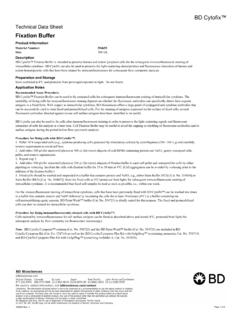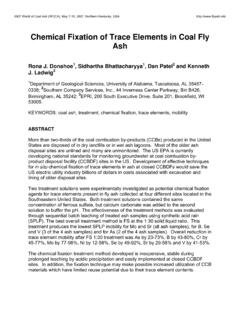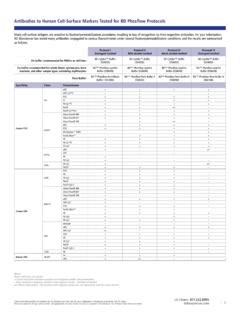Transcription of Aesculap Orthopaedics Targon PH Targon H - …
1 Aesculap OrthopaedicsTargon PH Targon HIntramedullary Nail System for the Proximal Humerus and the Humeral Shaft2 Fractures of the humeral shaft are generally treated conservativelywith early functional mobilization with great success. Nevertheless,there are a number of very good or relative indications for surgicaltreatment. Among the surgical methods involving internal fixationdevices, intramedullary nailing has increasingly gained in impor-tance. For such procedures, the retrograde approach proved to be anattractive surgical option as an alternative method to the traditio-nal antegrade approach, for certain fracture constellations. Some ofthe therapeutic failures reported in literature in conjunction withthe use of intramedullary nailing to treat humerus shaft fracturesare attributable to non-union of bone fragments.
2 The use of com-pression devices represents a simple method for counteracting thetendency to fragment displacement. The Targon line of humeralnails developed by Aesculap incorporates such features and therebycreates the preconditions for achieving a low rate of complicationsin connection with the internal fixation of such fixation of humeral head fractures by conventional methods,especially in patients with severe osteoporosis, suffers from highfailure rates. Therefore new, more successful fixation methods havebeen developed in recent years, among them Targon PH and Targon H, which have already convinced many users because theyreflect recent efforts to prevent the predominant complications discussed in the , 2006 Priv. Doz. Dr. StedtfeldHospital for Traumatology Nuremberg for strong connectionsH3 Pseudarthrosis is caused by excess elasticity in the supportingsystem and by relative displacements between the metaphysealfragments.
3 To prevent this complication, the capitellar nail provides rigid fixation of the capitellar fragments with highangular and relative displacement development of capitellar necrosis is also promoted by thecompressing effect of certain fixation techniques on the bran-ches of the circumflex humeral artery feeding the stability of fixation is another likely negative factor. Because the new interlocking screws penetrate the softtissue near the capitellum only at certain points, the bloodsupply is afforded maximum protection. The adjusting-screweffect of the interlock allows using the remaining possibilitiesto revascularize the fragments (even if the patient exercisesearly in the postoperative period). User experience over thefirst few years led to two modifications of the implant compo-nents:The fixation of crushed tubercles is carried out with a shortframe suture (rope-over-bitt method) around the head ofthe respective fixation screw.
4 The screw head profile wasslightly modified to hold of this suture more in patients with severe osteoporosis, spontane-ous untightening of the smoothly running fixation screwshas been observed. Therefore a plastic inlay (PEEK: Poly-EtherEtherKetone) was inserted as a screw brake in theupper nail section. In tests, Targon PH with PEEK inlayssuccessfully underwent 200 processing cycles. Finally, theTargon instruments were developed with special emphasison easy handling and practicality to offer optimum cost-efficiency for both main indication areas (humerus stemand humerus head).Excellent fixation stability To achieve optimally stablefracture fixation , the inter-locking screws ( fixation screws)in the capitellar area are an-chored within the nail with angular and displacement stability at various insertionangles congruent with the tubercles in the capitellum.
5 As a result, the position of the fragments relative to each other is maintained (set-screw effect) even underexercise early in the post-operative of the blood supply The blood supply to the capi-tellar fragments provided by the fine branches of the circumflex humeral artery can be damaged by surfacecompression, by a T-plate,and by the constricting effectof cerclage wires. Since theinterlocking screws, as peri-pheral load-bearing fixationelements, penetrate the tissueonly at certain points, damageto the soft-tissue zone nearthe capitellum is minimized so that the blood supply in the fractured capitellum is given a maximum chance of Solution for Fractures of the Capitellum4 Rope over bitt The nail locks the fragments in stable angular position. This is achieved by securing the mm screws in the PEEK inlay and imbedding the screwheads in the cortical bone ofthe corresponding tuberclefragment.
6 For splinter fractions,the fragments can be further fixated by short frame suturesbetween the tendon attach-ments and the screw subacromial passage The impingement of implantedges ( spiked wire ends,screw heads, plate edges, etc.)under the scapular roof causespainful irritation to such anextent that postoperative exercising schedules cannot be maintained. This poses therisk of permanent scarring inthe subacromial space and asevere loss of movement in the shoulder. To prevent this complication,the interlocking screw headsfeature a new thread designthat allows recessed insertionin the cortical bone of the capitellum. This allows the patient to start intensive exercising as soon as the postoperative inflammationsubsides so that the articularfunctionality of the sub-acromial bursa can be re-stored of IndicationNeer-Classification Targon PH indication6 Measurement of the tilt-ing displacement and tilt-ing force of the fixationscrew in the nail with andwithout screw brake With the same force applied,nails with screw brake allowroughly the same degree of tilt-ing as nails without screw brakeHowever, the tilting character-istic of nails without screwbrake is abrupt whereas thetilting is softer, more dampenedfor nails with the screw brakefeature.
7 This buffer effect pro-tects the joined setup: PH nail clamped in, with fixation screw and ,50,00,5-40-2002040 Displacement in mmForce in NForceless tiltingPH Nagel mit PEEK SchraubenbremsePH Nagel ohne PEEK SchraubenbremseDampened tilting PH nail with PEEK screw brakePH nail without PEEK screw brakeFor the PH nail withoutscrew brake the tiltingcurve is characterized by a forceless, abruptregion while the tiltingof a PH nail with screwbrake is softer, Solution for Fractures of the Capitellum+ Force / Displacement H7 The Solution for Fractures of the Humeral ShaftAntegrade or retrogradenail implantationThe selection of a suitable surgical approach is not just a question of the surgeon spersonal preferences. The ob-vious advantage of retrogradenail implantation is the extra-articular access. On the otherhand, the retrograde approachbecomes more and more prob-lematic ( risk of fracture of the bone bridge betweenthe edge of the fracture andthe nail insertion hole) thefurther distal the fracture is for shaft fractures lo-cated far toward proximal, the retrograde implantation of an intermedullary nail canbe complicated by poor ancho-ring of interlocking screws inthe metaphysis ( screwloosening in an osteoporoticbone bed).
8 However, the targeting device and the naildrill holes fully meet the re-quirements of both screw for optimized interlockingIn patients with high-gradeosteoporosis there is a dangerthat the interlocking screwsmay come loose and migrateinto the proximal humerus region. For this reason there is the option of using a fixationscrew ( mm) instead of anormal screw ( mm) foroptimal displacement and angular long version of the proximalhumeral nail is availableoffering several options forinterlocking with stability throughinterfragmentary compressionIn stable transverse fractures and short oblique fractures, in particular, inadequate con-tact between fragments hasthe effect of delaying or even preventing fracture healing. A compression device creates secure, close, interlocked fragment contact preventingrotation. The resulting freedomfrom pain and stability of thearm during early postoperativeexercise promotes rapid frac-ture locking holes with PEEK inlayAngular and displacementstability of the inserted screwDistal diameter8 mm/150 mm long 7 mm/200 280 mm longFixation screwsSpecial threaded design forcancellous boneLarge thread diameter on thescrew head for secure hold onbone fragmentsVery flat screw headSuture channel in the screwhead for rope over bitt fixationTransfixation holes hold mm interlockingscrews with proven, high-load thread design to stabilize on the distal side of the fracture lineSpecial surface treatment for.
9 Simple implantation and explantation no osteointegration minimal abrasion debrisAnatomical angular positioning of the fixation screws (capitellum,lesser and greater tubercle of thehumerus)Reduced probability of neural lesions right and left versionsProximal diameter 10 mmLocking screws prevent boneingrowth and allow easy explantation8 ImplantImplant material: Titanium alloy Ti6Al4 VPEEK (PolyEtherEtherKetone)Threaded locking holeallows using fixation screws ( patients with osteoporosis)allows compression with one screwfor angular and displacementstability of screw seatingSlotted hole compression path of 8 mmAngulation of 4 for easier retrograde implantation of the nailSpecial surface treatment for:simple implantation and explantation no osteointegration minimal abrasion debrisSlender nail, 7 or 8 mm diameterFour-way lockingoffers alternatives to standard interlocking proceduresenhanced stability in patients with mm interlocking screwsmade of a high-strength titanium alloy; proven designAsymmetric sliding tip for easy implantationAntegrade or retrograde approachLocking screws prevent bone ingrowth andallow easy explantationExtension screws allow bicortical proximal locking9 ImplantHImplant material:Titanium alloy Ti6Al4V Operating ManualPreoperative planningNail sizesPositioning of the fixation screwsAllocation of transfixationholesPatient position Beach chair position Shoulder free1011 ApproachDeltoid-split approach at the frontal end of the acromial margin.
10 Opening of the subacromial with an intact rotator cuff: Longitudinal incision of the cuff 1 cm dorsolateral of the palpatedbicipital groove in the direction of the fibers toward medial. Looping of the two incision edges andexposures of the capitellum. Repositioning of the capitellum (possibly with a Steinmann pin); monitoring by image with a defective rotator cuff: Dislocated tubercles, enlargement of the tear in the rotator cuff via an incision in the direction of the fibers. Opening and holding back of the tubercles laterally;repositioning of the capitellum with a Steinmann pin ("joystick procedure ).OpeningGuide pin KH161R Hollow reamer mm KH160 RRepositioning of the capitellum-bearing main fragmentwith a Steinmann pin ("joystick procedure ). Longitudinalincision of the supraspinatus tendon in fiber of the guide pin at the most cranial point of the capitellum.











